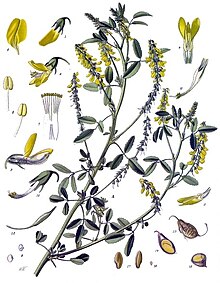Yellow sweet clover
| Yellow sweet clover | ||||||||||||
|---|---|---|---|---|---|---|---|---|---|---|---|---|

Yellow sweet clover ( Melilotus officinalis ) |
||||||||||||
| Systematics | ||||||||||||
|
||||||||||||
| Scientific name | ||||||||||||
| Melilotus officinalis | ||||||||||||
| ( L. ) Pall. |
The Yellow sweet clover ( Melilotus officinalis ), also Common clover , melilot , (usual) sweet clover and sweet clover called, is a plant from the family of legumes (Fabaceae).
description
Appearance and leaf
The yellow sweet clover is a biennial to perennial herbaceous plant that reaches heights of 30 to 100 (up to 200) centimeters. It has upright and branched stems .
The alternate leaves are arranged in a petiole and a leaf blade. The imparipinnate leaf blade has three petiolate leaflets. On the pinna leaflet are 6 to 14 pairs of lateral nerves exist. The stipules are entire or (the middle and lower) provided with a tooth at the base on each side.
Inflorescence, flower and fruit
The flowering period extends from June to September. The racemose inflorescences are 4 to 10 centimeters long.
The hermaphrodite flowers are zygomorphic and five-fold with a double flower envelope . The five petals are yellow. The 5 to 7 millimeter long corolla has the typical shape of the butterfly flower . The wings are longer than the shuttle . The wings are fused with the boat at the base. The only carpel is bare.
The bare fruits (transitional forms between legumes and nuts ) are one (or two) seeded, they do not crack open or only imperfectly and are only about 3 to 5 millimeters long. The fruits are cross-wrinkled and brown when ripe.
Chromosome number
The number of chromosomes is 2n = 16.

ecology
The yellow sweet clover is a hemicryptophyte . The taproot, rising at an angle, reaches a depth of 90 centimeters. It has root nodules with nitrogen-fixing bacteria. The plant is a raw floor pioneer.
Its leaflets have leaf joints and fold together at night ( nyctinasty ).
From an ecological point of view, it is a matter of "nectar-bearing butterfly flowers with a folding mechanism". The petals are colored yellow by carotenoids . The flowers are rich in nectar and smell of honey (the flowers - flores meliloti - were used as a medicinal ingredient in the Middle Ages). The yellow sweet clover is a nectar and pollen donor of particular value. Because the corolla tube is only 2 millimeters long, the nectar is also accessible to short-nosed insects . Pollinators are bees and hoverflies .
The fruits are spread by the wind and possibly also by humans.
distribution
The home of the yellow sweet clover is Central Europe and Asia. It is absent in Portugal and only occurs in Eastern Europe in the Danube Delta and around Odessa . Its status in the British Isles and Scandinavia is questionable. It was brought to North America as a forage crop and is now also found in Africa and Australia.
Occurrence
The yellow sweet clover grows widespread in sunny weed meadows , on paths, in railway areas, in quarries, on cracks in the earth , on banks and rubble sites. It thrives best on alkaline , calcareous and moderately nitrogen-poor soils . It is occasionally absent in areas with lime-poor rock. According to Ellenberg , it is a light plant and a dry pointer that grows on low-nitrogen locations. He is a trim characteristic species requiring heat and dryness yield forming, two years to persistent Ruderalfluren ( Onopordetalia acanthii ). In Germany, however, it is a character species of the Echio-Melilotetum in the Dauco-Melilotion Association, but also occurs in societies of the Convolvulo-Agropyrion or Caucalidion associations.
photos
Web links
- Melilotus officinalis (L.) Lam., Sweet clover. In: FloraWeb.de.
- Yellow sweet clover . In: BiolFlor, the database of biological-ecological characteristics of the flora of Germany.
- Profile and distribution map for Bavaria . In: Botanical Information Hub of Bavaria .
- Melilotus officinalis Lam. In: Info Flora , the national data and information center for Swiss flora . Retrieved November 15, 2015.
- Distribution in the northern hemisphere according to Eric Hultén
- Thomas Meyer: Data sheet with identification key and photos at Flora-de: Flora von Deutschland (old name of the website: Flowers in Swabia ).
- Medicinal plants - awl.ch .
- Pharmacy University of Greifswald .
Individual evidence
- ↑ a b Erich Oberdorfer : Plant-sociological excursion flora for Germany and neighboring areas. 8th edition, Stuttgart, Verlag Eugen Ulmer, 2001, ISBN 3-8001-3131-5 , pp. 586-587.
- ↑ Volker Zimmermann: The Heidelberg Pharmacopoeia Ysack Leuj. Contributions of Jewish Doctors to Medieval Medicine. Franz Steiner, Stuttgart 2018, ISBN 978-3-515-12174-3 , p. 62 f.
- ↑ Euro + Med Plant base: Distribution of yellow sweet clover .
- ↑ United States Forest Service: Yellow Sweetclover .








